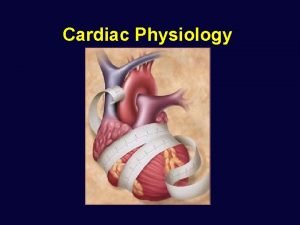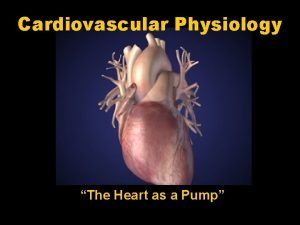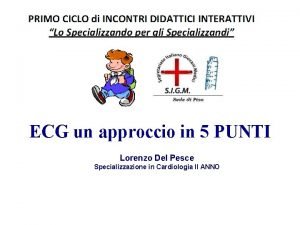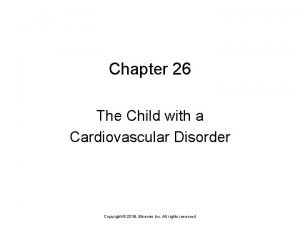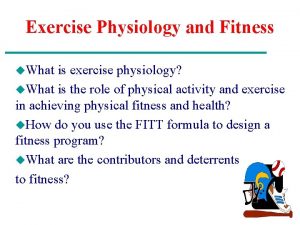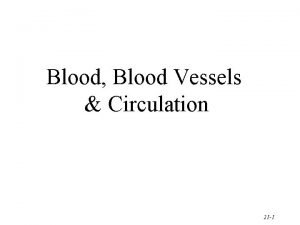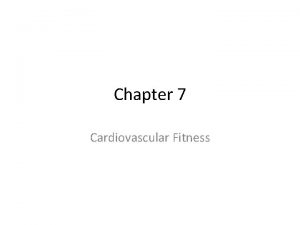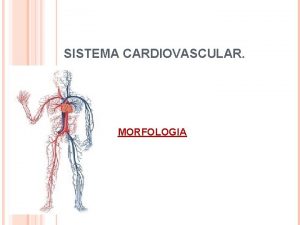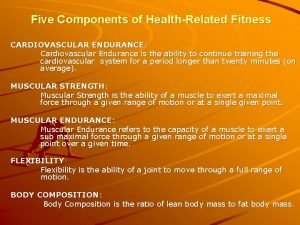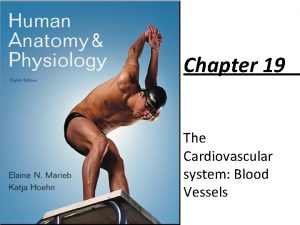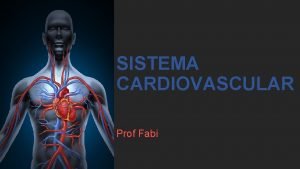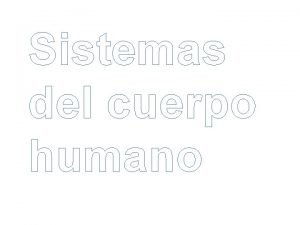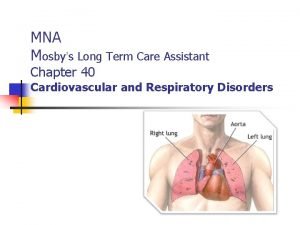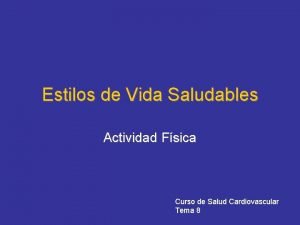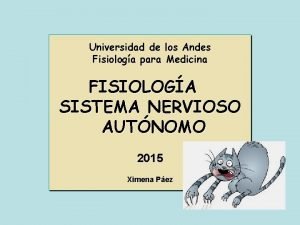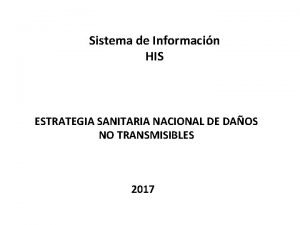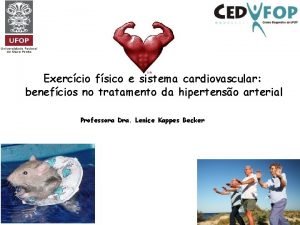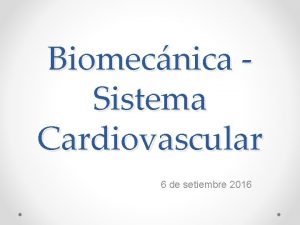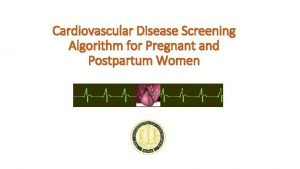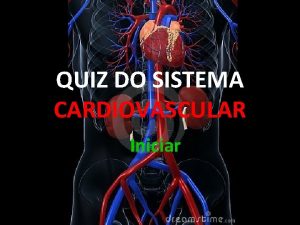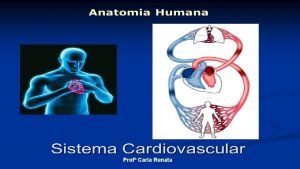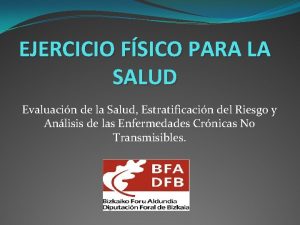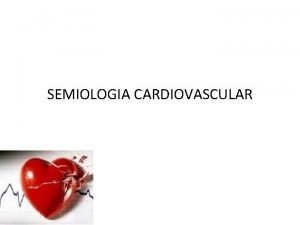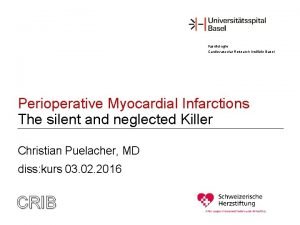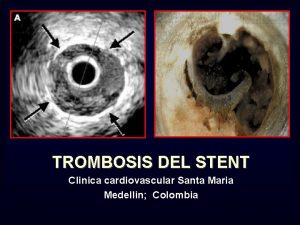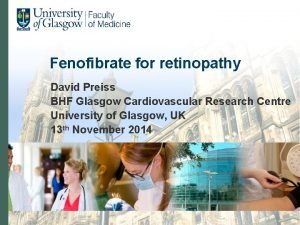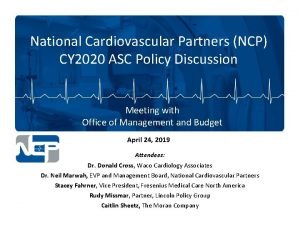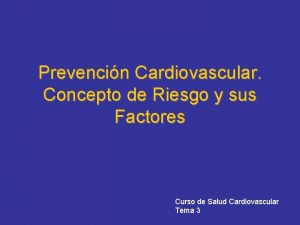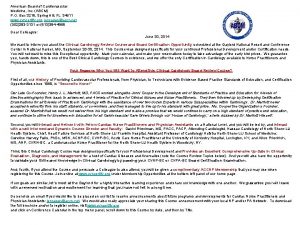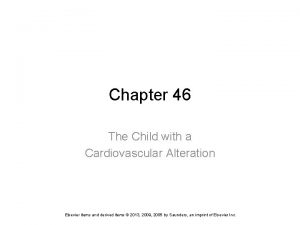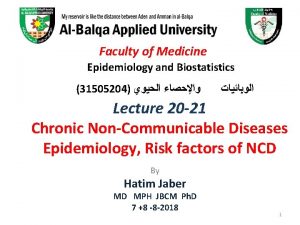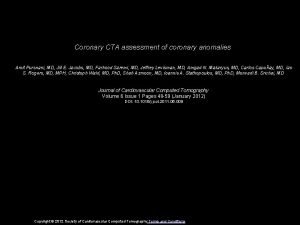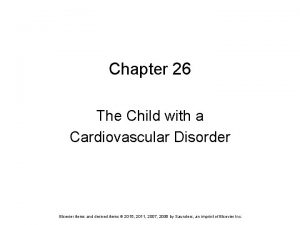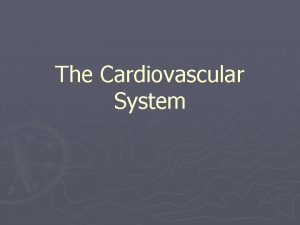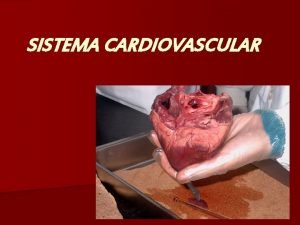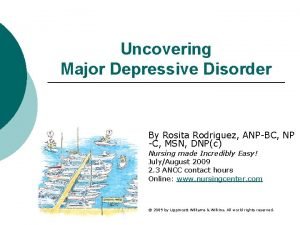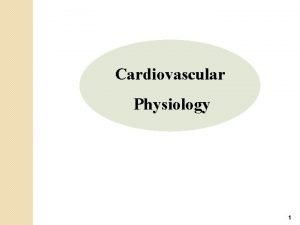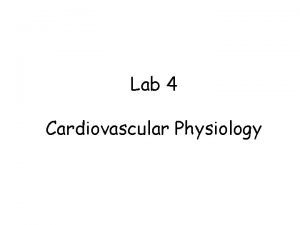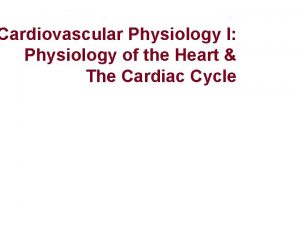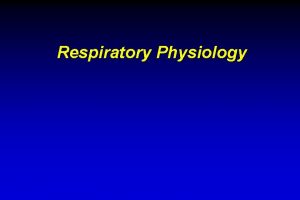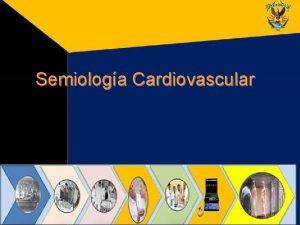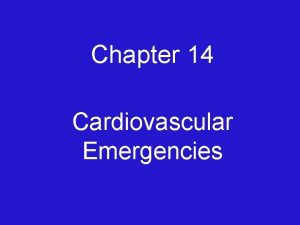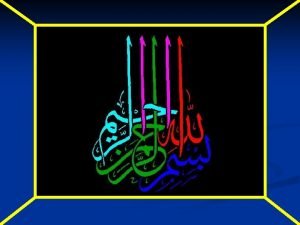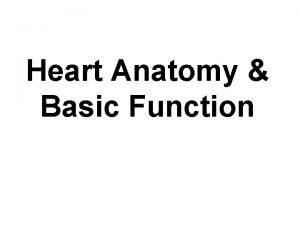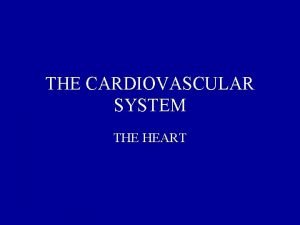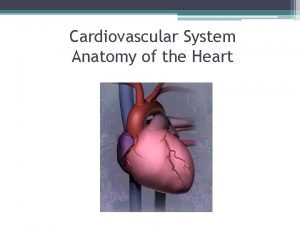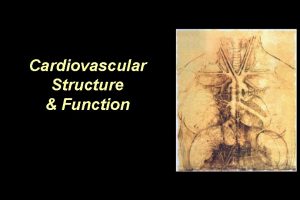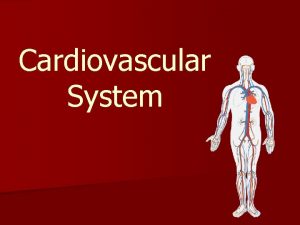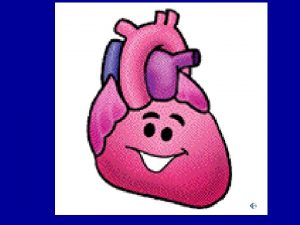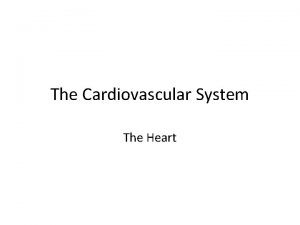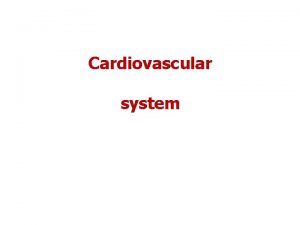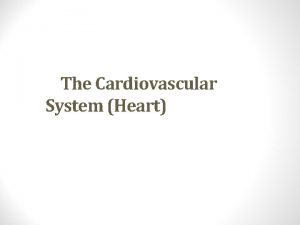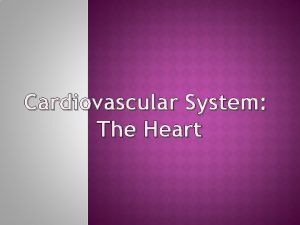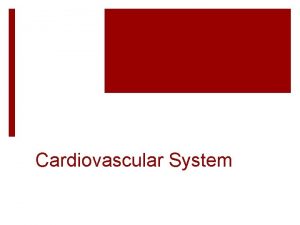Cardiovascular Physiology I Physiology of the Heart The




























































































- Slides: 92

Cardiovascular Physiology I: Physiology of the Heart & The Cardiac Cycle

References: Seeley, R. , Stephens, T. , and Tate, P. , Anatomy & Physiology. 8 th ed. Mc. Graw Hill Company Inc. , (2008) l Guyton, A. , Hall, J. , Textbook of Medical Physiology. 11 th ed. WB Saunders Co. (2006) • Martini, F. , Fundamentals of Anatomy & Physiology. 6 th ed. Benjamin Cummings Inc (2003) l

Part I FUNCTIONS OF THE CARDIOVASCULAR SYSTEM


Function of the CV System: Blood l Transport l Protection l Regulation

Function of the CV System: Heart l Generating BP l Blood routing l Ensuring one-way blood flow l Regulating blood supply

Function of the CV System: Blood Vessels Carry blood l Gas & nutrient exchange l Transport l BP regulation l Direct blood flow l

Part II THE CARDIAC CYCLE

Cardiac cycle l Events occurring from the beginning of one heartbeat to the beginning of the next l Consists of 2 periods as to the activity of the ventricles

Cardiac Cycle Systole – period of contraction l Isovolumetric contraction l Ejection l Diastole – period of relaxation l Isovolumetric Relaxation l Passive Ventricular filling l Atrial Contraction l

Isovolumetric Contraction l Ventricular contraction causing abrupt ↑ Po l AV valves close l Continuous contraction to overcome aortic & pulmonary arterial Po and open SL valves


Ejection (L) ventricular Po reaches 80 mm. Hg & ® ventricular Po reached 8 mm. Hg • SL valves open, then close • 70% ejected in the 1 st 1/3 of the period: rapid ejection • 30% ejected in the next 2/3 of the period: slow ejection l


Isovolumetric Relaxation Ventricular relaxation causes rapid ↓ of intraventricular Po l SL valves close d/t Po increase in the large arteries l Further ↓ in intraventricular Po would cause opening of AV valve. l


Passive Filling ~75% of the blood from the great veins l AV valves are open and semilunar valves closed l ↑ intraventricular Po relative to the atrium would slow down filling: Diastasis l

Atrial Contraction of atria will eject the remaining 25% into the ventricles


Ventricular Volumes Relative to Systolic and Diastolic contractions Volume of Blood in the Ventricle END-DIASTOLIC VOLUME STROKE VOLUME OUTPUT END SYSTOLIC VOLUME EJECTION FRACTION (110 -120 m. L) (-70 m. L) What remains after systole (40 -50 m. L) Usually 60%

Pressure-Volume Relationships during the cardiac cycle

Summary of Pressure Volume Relationships l CARDIAC CYCLE TABLE SUMMARY. pdf

Heart Valves l Atrioventricular valves l l Prevent back flow of blood between ventricles and atria Semilunar valves l Prevent back flow of blood between aorta (and pulmonary artery) and ventricles

Heart Valves l Papillary mm l Pull on the cusps of the AV valves during systole l Do not help valve closure l Prevent bulging into the atria

Heart Valves and Heart Sounds l 1 st heart sound: Lub l closure of the AV valves l Heard during systole l Relatively low in pitch and long l 2 nd heart sound: Dup l Closure of the SL valves l Heard during diastole l Rapid snap l Shorter

Heart Valves and Heart Sounds l 3 rd heart sound l Mid-diastole l Blood oscillation as it rushes from the aorta l Weak rumbling sound l 4 th heart sound l Atrial contraction l Inrush of blood into the ventricles l Low frequency sound


Heart Valves and Abnormal Heart Sounds l Murmurs: Abnormal Heart Sounds l Valvular Stenosis: Opening is too small l Valvular Regurgitation: Valve does not close completely

Heart Valves and Abnormal Heart Sounds SL Valve AV Valve Regurgitation Diastole High pitch, swishing Systole High pitch, swishing Stenosis Systole Loud and harsh Diastole Weak and low frequency

Part III CARDIAC ELECTROPHYSIOLOGY


Let’s review!

Cardiac Muscle Action Potential


Cardiac Muscle Action Potential l RMP of cardiac muscle: -90 m. V l Overshoots until ~+20 m. V

Phase 0: Rapid Depolarization opening of fast acting Na channels and slow acting Ca channels l Fast Na channels immediately close l

Phase 1: Partial Repolarization Closed Na channels l Partially repolarized d/t efflux of K l

Phase 2: Plateau Full opening of Ca channels counteracting K efflux l Ca influx is involved in excitationcontraction l

Phase 3: Rapid Repolarization Gradual in K efflux l Ca channels close l l Phase 4: Return to Resting Membrane Potential

Cardiac Muscle Excitation. Contraction Coupling l Phase 2 l Action potential spreads to interior via T-tubules l Excitation of T-tubules promote Ca release from sarcoplasmic reticulum adding to Ca influx l Actin-Myosin binding

Cardiac Muscle Excitation – Contraction Coupling l Phase 3 l Ca influx is cut l Ca ions are pumped back into the sarcoplasmic reticulum l relaxation

Part IV CONDUCTING SYSTEM OF THE HEART

Conducting System of the Heart l Sinoatrial Node l Superior posterolateral wall of ® atrium, below and lateral to SVC opening l Non-contractile l Self excitatory

Conducting System of the Heart l Sinoatrial node l RMP of -55 to -60 m. V l Firing level of -40 m. V l Depolarization only by opening of slow Na-Ca channels

Conducting System of the Heart

Conducting System of the Heart Internodal pathways l Anterior Tract of Bachman l Middle Tract of Wenckebach l Posterior Tract of Thorel l Impulses converge on the Atrioventricular node l

Conducting System of the Heart l Atrioventricular Node l Posterior wall of ® atrium, adjacent to coronary sinus l Delay of impulse conduction allows full contraction of atrium

Conducting System of the Heart l Bundle of His l Located on either side of interventricular septum l Conducts impulses from atria to ventricles

Conducting System of the Heart l Purkinje Fibers l Conducting tissues of the ventricles

Conducting System of the Heart l l Why is the SA node the pacemaker of the heart? Frequency of impulse production is faster Structure Impulses/min SA 70 -80 AV 40 -60 Purkinje Fibers 15 -40 Greater rhythmicity depresses other potential pacemakers

The Electrocardiogram l a graphic representation of the electrical activity generated by the atria and ventricles.

The Electrocardiogram Strip l. Small block = 1 mm l. TIME (x-axis) l. Small block = 0. 04 second l. Bold block = 0. 20 second

The Electrocardiogram Strip l AMPLITUDE (yaxis) l. Small block = 0. 1 m. V l Rate: 22 mm/second

The Electrocardiogram: Einthoven’s Triangle

The Electrocardiogram: Precordial Leads

The Electrocardiogram When a positive wave of depolarization within the heart cells moves toward a positive skin electrode, there is an upward deflection on the ECG




The Electrocardiogram

The Electrocardiogram

The Electrocardiogram P-WAVE l The first positive deflection on the ECG. l Atrial depolarization


The Electrocardiogram PR INTERVAL l time required for the impulse to travel from the SA node through the conduction system to the Purkinje fibers

The Electrocardiogram QRS Complex l Ventricular depolarization l Atrial repolarization is not seen

The Electrocardiogram ST SEGMENT l represents the beginning of ventricular muscle repolarization

The Electrocardiogram T WAVE l representing ventricular repolarization


The Electrocardiogram

Interpreting the Electrocardiogram l Heart Rate l l # of QRS complexes is a 6 second strip x 10 # of QRS complexes in a 3 second strip x 20

Interpreting the Electrocardiogram l Heart Rate = 300 / # of big squares between 2 QRS complex l Triplicate system 300 – 150 – 100 – 75 – 60 - 50

Anatomic Representation in the ECG l Inferior wall l II, III, AVF l Anterior Wall l V 1, V 2, V 3, V 4 l Lateral Wall l I, AVL, V 5, V 6 l Superior Wall l AVR

Part V CARDIAC REGULATION

Intrinsic Cardiac Regulation l Largely determined by Preload l The degree to which the ventricular walls are stretched at the end of diastole l Determined by venous return (amount of blood returning to the heart)

Intrinsic Cardiac Regulation l Starling’s Law of the Heart l Relationship between preload and force of cardiac contraction l preload = contraction force = SV

Intrinsic Cardiac Regulation l Starling’s Law of the Heart l Major influence on stroke volume (amount of blood ejected by the heart every cardiac cycle) and cardiac output (amount of blood ejected by the heart in one minute) CO = SV x HR = 5* L/min

Stroke Volume and Inotropic regulation l Inotropic effects l Force of Contraction l ↑ inotropic effect = ↑ force of contraction = ↑ amount of blood ejected

Intrinsic Cardiac Regulation

Intrinsic Cardiac Regulation l Afterload l pressure against which the ventricles must pump blood l afterload= work of cardiac mm = SV

Extrinsic Cardiac Regulation l Hormonal l Catecholamines l Neuronal l Autonomic nervous system l Cardiorespiratory centers of the medulla

Extrinsic Cardiac Regulation l Other control mechanisms l Barorecpetor and chemoreceptor l Temperature l Electrolyte levels (K, Na, Ca)

Extrinsic Cardiac Regulation: Neuronal influences l Sympathetic l l Cardioaccleratory center stimulation = HR and contractility (SV)

Extrinsic Cardiac Regulation: Neuronal Influences l Parasympathetic l l Cardioinhibitory center stimulation = HR and contractility (SV)

Extrinsic Cardiac Regulation: Hormonal influences l Catecholamines l Norepinephrine and Epinephrine : sympathetic stimulation

Extrinsic Cardiac Regulation: Reflex Mechanisms l Baroreceptor & Chemoreceptor reflex

Extrinsic Cardiac Regulation: Other Control Mechanisms l Na & Ca levels l Direct relation with HR l K levels l Inverse relation with HR

Extrinsic Cardiac Regulation: Other Control Mechanisms l Temperature l 1 o. C = 4 bpm l Coronary blood flow l coronary blood flow = contractility

Extrinsic Cardiac Regulation: other Control Mechanisms l Bainbridge reflex l relationship of venous return with heart rate l VR = HR

Heart Rate and Chronotropic Regulation l Chronotropic effects l Speed of contraction l ↑ chronotropic effects = ↑ speed of contraction = ↑ amount of blood ejected

Ejection Fraction and Heart Function l Determines how much of the blood entering the ventricles is pumped (End-Diastolic ventricular Volume - Endsystolic ventricular volume) End diastolic ventricular volume l (N) 63 -77% for males and 55 -75% for females

The Hypoeffective Heart Inhibition of nervous excitation l Ab. N heart rhythm l Valvular heart disease l Hypertension l Cardiac anoxia l Myocardial damage l

THE END
 Anatomy and physiology unit 7 cardiovascular system
Anatomy and physiology unit 7 cardiovascular system Describe the intrinsic conduction system of the heart
Describe the intrinsic conduction system of the heart Heart as a pump physiology
Heart as a pump physiology Cardiac dullness
Cardiac dullness Left atrium sheep heart
Left atrium sheep heart Stars dogs plowhorses and puzzles
Stars dogs plowhorses and puzzles Life
Life Capillary bed
Capillary bed Chapter 26 the child with a cardiovascular disorder
Chapter 26 the child with a cardiovascular disorder What is fitness
What is fitness What does peripheral resistance mean
What does peripheral resistance mean Fitness chapter 7
Fitness chapter 7 Características de los vasos sanguíneos
Características de los vasos sanguíneos Rias cardiovascular
Rias cardiovascular What are the components of fitness?
What are the components of fitness? Chapter 11 the cardiovascular system
Chapter 11 the cardiovascular system Chapter 19 the cardiovascular system blood vessels
Chapter 19 the cardiovascular system blood vessels Cardiovascular system crash course
Cardiovascular system crash course Foto do sistema cardiovascular
Foto do sistema cardiovascular Paratiroidea
Paratiroidea Cardiovascular disorders
Cardiovascular disorders Salud cardiovascular
Salud cardiovascular When does stroke volume increase
When does stroke volume increase Receptores sensoriales
Receptores sensoriales Riesgo cardiovascular por perimetro abdominal
Riesgo cardiovascular por perimetro abdominal Sistole
Sistole Wolters kluwer
Wolters kluwer Exercício fisico
Exercício fisico Sistema cardiovascular sus partes
Sistema cardiovascular sus partes Chapter 16 cardiovascular emergencies
Chapter 16 cardiovascular emergencies Pithed rat model
Pithed rat model Ptca
Ptca Lesson 11 cardiovascular system
Lesson 11 cardiovascular system Cmqcc cardiovascular toolkit
Cmqcc cardiovascular toolkit Chapter 5 learning exercises medical terminology
Chapter 5 learning exercises medical terminology Sistema cardiovascular quiz
Sistema cardiovascular quiz Sistema cardiovascular
Sistema cardiovascular Atraumatic tip
Atraumatic tip Fsico
Fsico Maniobra de azoulay
Maniobra de azoulay Isgemiese hartsiekte
Isgemiese hartsiekte Agranulocytes
Agranulocytes Clinica cardiovascular santa maria
Clinica cardiovascular santa maria Bhf glasgow cardiovascular research centre
Bhf glasgow cardiovascular research centre Chapter 11 the cardiovascular system figure 11-3
Chapter 11 the cardiovascular system figure 11-3 Chapter 11 the cardiovascular system figure 11-2
Chapter 11 the cardiovascular system figure 11-2 Chapter 13 cardiovascular system
Chapter 13 cardiovascular system Fresenius ncp
Fresenius ncp Salud cardiovascular
Salud cardiovascular American board of cardiovascular medicine
American board of cardiovascular medicine Chapter 46 the child with a cardiovascular alteration
Chapter 46 the child with a cardiovascular alteration Cardiovascular disease risk factor
Cardiovascular disease risk factor Journal of cardiovascular computed tomography
Journal of cardiovascular computed tomography Cardiovascular system diseases and disorders chapter 8
Cardiovascular system diseases and disorders chapter 8 What makes up the cardiovascular system
What makes up the cardiovascular system Introduction of cardiovascular system
Introduction of cardiovascular system Chapter 11 the cardiovascular system
Chapter 11 the cardiovascular system Blood vesel
Blood vesel Chapter 26 the child with a cardiovascular disorder
Chapter 26 the child with a cardiovascular disorder Chapter 11 the cardiovascular system figure 11-10 answers
Chapter 11 the cardiovascular system figure 11-10 answers The cardiovascular system includes the
The cardiovascular system includes the Pequena circulação e grande circulação
Pequena circulação e grande circulação Cardiovascular drugs
Cardiovascular drugs Its tubular dude
Its tubular dude Agility
Agility Frameset trong html5
Frameset trong html5 Hệ hô hấp
Hệ hô hấp Thế nào là số nguyên tố
Thế nào là số nguyên tố đặc điểm cơ thể của người tối cổ
đặc điểm cơ thể của người tối cổ Vẽ hình chiếu vuông góc của vật thể sau
Vẽ hình chiếu vuông góc của vật thể sau Các châu lục và đại dương trên thế giới
Các châu lục và đại dương trên thế giới Tư thế worms-breton
Tư thế worms-breton ưu thế lai là gì
ưu thế lai là gì Tư thế ngồi viết
Tư thế ngồi viết Cái miệng bé xinh thế chỉ nói điều hay thôi
Cái miệng bé xinh thế chỉ nói điều hay thôi Các châu lục và đại dương trên thế giới
Các châu lục và đại dương trên thế giới Mật thư tọa độ 5x5
Mật thư tọa độ 5x5 Bổ thể
Bổ thể Tư thế ngồi viết
Tư thế ngồi viết Giọng cùng tên là
Giọng cùng tên là Thẻ vin
Thẻ vin Thơ thất ngôn tứ tuyệt đường luật
Thơ thất ngôn tứ tuyệt đường luật Chúa yêu trần thế
Chúa yêu trần thế Hổ sinh sản vào mùa nào
Hổ sinh sản vào mùa nào Từ ngữ thể hiện lòng nhân hậu
Từ ngữ thể hiện lòng nhân hậu Diễn thế sinh thái là
Diễn thế sinh thái là Vẽ hình chiếu vuông góc của vật thể sau
Vẽ hình chiếu vuông góc của vật thể sau Phép trừ bù
Phép trừ bù Tỉ lệ cơ thể trẻ em
Tỉ lệ cơ thể trẻ em Lời thề hippocrates
Lời thề hippocrates Vẽ hình chiếu đứng bằng cạnh của vật thể
Vẽ hình chiếu đứng bằng cạnh của vật thể đại từ thay thế
đại từ thay thế Quá trình desamine hóa có thể tạo ra
Quá trình desamine hóa có thể tạo ra

